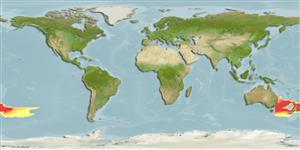>
Scombriformes (Mackerels) >
Centrolophidae (Medusafishes)
Etymology: Tubbia: Because of Mr. J. Allan Tubb (Ref. 45335); stewarti: Named for Andrew Stewart, an ichthyologist from New Zealand..
Environment: milieu / climate zone / depth range / distribution range
Ecologia
marino batipelagico; distribuzione batimetrica 30 - 1438 m (Ref. 93030). Tropical
Southwest Pacific: confirmed from off Australia and New Zealand in the Southern Hemisphere'; possibly more widespread in the southern Indian Ocean but this needs confirmation.
Size / Peso / Age
Maturity: Lm ? range ? - ? cm
Max length : 56.0 cm SL maschio/sesso non determinato; (Ref. 93030)
The juveniles (6.1-9.9 cm SL) were collected from the epipelagic zone at 30-50 m depth; larger individuals (11.0-56.1 cm SL) occur much deeper in the mesopelagic zone at 525-1438 m depth (Ref. 93030).
Life cycle and mating behavior
Maturità | Riproduzione | Deposizione | Uova | Fecundity | Larve
Last, P.R., R.K. Daley and G. Duhamel, 2013. A review of the ruddersfish genus Tubbia (Stromateoidei: Centrolophidae) with the description of a new species from the Southern Hemisphere. Zootaxa 3616(5):461-477. (Ref. 93030)
IUCN Red List Status (Ref. 130435)
Threat to humans
Harmless
Human uses
Informazioni ulteriori
Nomi ComuniSinonimiMetabolismoPredatoriEcotossicologiaRiproduzioneMaturitàDeposizioneSpawning aggregationFecundityUovaEgg development
Age/Size
Accrescimento
Length-weight
Length-length
Length-frequencies
Morfometria
Morfologia
Larve
Dinamica popolazioni larvali
Reclutamento
Abbondanza
BRUVS
BibliografiaAcquacolturaProfilo di acquacolturaVarietàGeneticaElectrophoresesEreditarietàMalattieElaborazioneNutrientsMass conversion
CollaboratoriImmaginiStamps, Coins Misc.SuoniCiguateraVelocitàModalità di nuotoArea branchialeOtolithsCervelliVista
Strumenti
Special reports
Download XML
Fonti Internet
Estimates based on models
Preferred temperature (Ref.
123201): 8 - 13.4, mean 9.9 °C (based on 57 cells).
Phylogenetic diversity index (Ref.
82804): PD
50 = 0.7500 [Uniqueness, from 0.5 = low to 2.0 = high].
Bayesian length-weight: a=0.00891 (0.00406 - 0.01955), b=3.10 (2.91 - 3.29), in cm total length, based on LWR estimates for this (Sub)family-body shape (Ref.
93245).
Trophic level (Ref.
69278): 3.8 ±0.6 se; based on size and trophs of closest relatives
Resilienza (Ref.
120179): Medio, tempo minimo di raddoppiamento della popolazione 1.4 - 4.4 anni (Preliminary K or Fecundity.).
Fishing Vulnerability (Ref.
59153): Moderate to high vulnerability (47 of 100).
